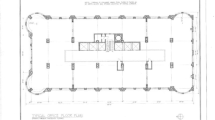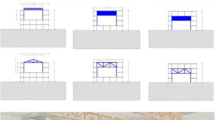Abstract
In the last decade, various types of transformable building structures have been developed, such as deployable tensegrity, scissor-like and origami-inspired systems, as well as reconfigurable rigid-bar linkage and adaptive compliant structures. The development of the systems owns to advances in material design and kinetics, while aiming at an improved sustainability of the built environment. Their conceptualization and investigation have been enabled through associative parametric design and numerical analysis facilities that meanwhile provide robust digital visualizations and numerical analysis models. In principle, responsive building structures are capable to adapt to changing functional, loading, or environmental conditions. At university level, the integrated architectural design that involves an integrative development of the building form, functions and technical system parameters is increasingly enriched by performance-based design approaches through interdisciplinary experimentation and design-driven research, i.e., ‘integrated interdisciplinary design’, for the achievement of efficiency, sustainability and technological innovation in architecture. The paper discusses related influencing modes and preliminary design results of an integrated interdisciplinary approach driven by aspects of modularity, flexibility, transportability, deployability, adaptivity and interactivity, as well as their implications towards a framework of related research. The design projects presented have been supervised by the authors in recent years at the University of Cyprus and the University of Stuttgart. In all cases, the design methodology followed enables students to consider related morphological, functional and structural requirements, while being exposed to transformable building structures as related to aspects of materiality, functionality, sustainability and aesthetics.




















Similar content being viewed by others
Data availability
Not applicable.
Code availability
Not applicable.
References
Kronenburg R (2007) Flexible. Architecture that responds to change. Laurence King, London
Engel H (1999) Structure systems, 2nd edn. Gerd Hatje Verlag, Ostfildern-Ruit
Lienhard J, Knippers J (2013) Considerations on the scaling of bending-active structures. Int J Space Struct 28:137–148. https://doi.org/10.1260/0266-3511.28.3-4.137
Zuk W, Clark RH (1970) Kinetic architecture. Van Nostrand Reinhold, New York
Fenci GE, Currie NGR (2017) Deployable structures classification: a review. Int J Space Struct 32(2):112–130. https://doi.org/10.1177/0266351117711290
Pugh A (1976) An introduction to tensegrity. University of California Press, Berkeley
Tibert AG, Pellegrino S (2003) Review of form-finding methods for tensegrity structures. Int J Space Struct 18(4):209–223. https://doi.org/10.1260/026635103322987940
Escrig F (1985) Expandable space structures. Int J Space Struct 2(1):79–91. https://doi.org/10.1177/026635118500100203
Gantes CJ (2001) Deployable structures: analysis and design. WIT Press, Southampton
You Z, Pellegrino S (1997) Foldable bar structures. Int J Solids Struct 15(34):1825–1847. https://doi.org/10.1016/S0020-7683(96)00125-4
Chen Y, Peng R, You Z (2015) Origami of thick panels. Science 349(6246):396–400. https://doi.org/10.1126/science.aab2870
Li S, Fang H, Sadeghi S, Bhovad P, Wang KW (2019) Architected origami materials: how folding creates sophisticated mechanical properties. Adv Mater 31(5):1805282. https://doi.org/10.1002/adma.201805282
Phocas MC, Christoforou EG, Matheou M (2015) Design, motion planning and control of a reconfigurable hybrid structure. Eng Struct 101(10):376–385. https://doi.org/10.1016/j.engstruct.2015.07.036
Thrall AP, Adriaenssens S, Paya-Zaforteza I, Zoli TP (2012) Linkage-based movable bridges: design methodology and three novel forms. Eng Struct 37:214–223. https://doi.org/10.1016/j.engstruct.2011.12.031
Lienhard J (2014) Bending-active structures. Form-finding strategies using elastic deformation in static and kinetic systems and the structural potentials. Dissertation, University of Stuttgart
Phocas MC, Alexandrou K (2018) On decoding the structural behavior of hybrid cable bending-active units in fastening, prestress and load-bearing state. Int J Space Struct 33(2):98–111. https://doi.org/10.1177/0266351118795338
Adam B, Smith IFC (2008) Active tensegrity: a control framework for an adaptive civil-engineering structure. Compos Struct 86(23–24):2215–2223. https://doi.org/10.1016/j.compstruc.2008.05.006
Ganga PL, Micheletti A, Podio-Guidugli P, Scolamiero L, Tibert G, Zolesi V (2016) Tensegrity rings for deployable space antennas: concept, design, analysis, and prototype testing. In: Frediani A, Mohammadi B, Pironneau O, Cipolla V (eds) Variational analysis and aerospace engineering, vol 116. Springer, Cham, optimization and its applications, pp 269–304. https://doi.org/10.1007/978-3-319-45680-5_11
Hanaor A (1998) Tensegrity. Theory and application. In: Francois GJ (ed) Beyond the cube. Wiley, New York, pp 385–405
Tibert G (2002) Deployable tensegrity structures for space applications. Dissertation, Stockholm Royal Institute of Technology
Hoberman C (1993) Unfolding architecture: an object that is identically a structure and a mechanism. Arch Des 63:53–59
Akgün Y, Gantes CJ, Kalochairetis K, Kiper G (2010) A novel concept of convertible roofs with high transformability consisting of planar scissor-hinge structures. Eng Struct 32:2873–2883. https://doi.org/10.1016/j.engstruct.2010.05.006
Akgün Y, Gantes CJ, Sobek W, Korkmaz K, Kalochairetis K (2011) A novel adaptive spatial scissor-hinge structural mechanism for convertible roofs. Eng Struct 33(4):1365–1376. https://doi.org/10.1016/j.engstruct.2011.01.014
Alegria Mira L, Filomeno Coelho R, Thrall AP, De Temmerman N (2015) Parametric evaluation of deployable scissor arches. Eng Struct 99:479–491. https://doi.org/10.1016/j.engstruct.2015.05.013
Christoforou EG, Phocas MC, Matheou M, Müller A (2019) Experimental implementation of the ‘effective 4-bar method’ on a reconfigurable articulated structure. Struct. 20:157–165. https://doi.org/10.1016/j.istruc.2019.03.009
Phocas MC, Christoforou EG, Dimitriou P (2020) Kinematics and control approach for deployable and reconfigurable rigid bar linkage structures. Eng Struct 208:110310. https://doi.org/10.1016/j.engstruct.2020.110310
Anastasiadou I, Phocas MC (2020) Deformation control and shape adaptation of a hybrid bending-active gridshell. In: Choi C-K (ed) The 2020 Structures Congress, Structures20, 2020 International Conference on Advances in Computational Design. Seoul
Ferre A (2007) Patent constructions. New Architecture made in Catalonia. Actar, Barcelona
Phocas MC, Alexandrou K (2018) Numerical analysis and cable activation in hybrid bending-active structures with multiple cables. Eng Struct 174:561–572. https://doi.org/10.1016/j.engstruct.2018.07.089
Kolarevic B, Parlac V (2015) Building dynamics: exploring architecture of change. Routledge, Oxon
Temmerman ND, Roovers K, Mira LA, Verauwen A, Koumar A, Brancart S, Laet LD, Mollaert M (2013) Engineering lightweight transformable structures. In: Proceeding of International Conference of Adaptation and Movement in Architecture, ICAMA 2013, Toronto, pp. 44–57
Hoffmann S, Barej M, Puppa GD, Hüsing M, Trautz M, Corves B (2013) Interdisciplinary design of movable structures in architecture education. In: Proceedings of the first Conference Transformables 2013. In the Honor of Emilio Perez Pinero, Seville, pp. 411–416
Fox M, Yeh B (1999) Intelligent kinetic system. MIT, Massachusetts
Fox M, Hu C (2005) Starting from the micro: a pedagogical approach to designing interactive architecture. In: ACADIA05: smart architecture
Oxman R (2008) Digital architecture as a challenge for design pedagogy: theory, knowledge, models and medium. Des Stud 29:99–120. https://doi.org/10.1016/j.destud.2007.12.003
Masengarb J, Rehbein K (2007) The architecture handbook: a student guide to understanding buildings. Chicago Architecture Foundation, Chicago
Busby Perkins + Will (2010) Roadmap for the integrated design process. BC Green Building Round Table, Vancouver. http://www.greenspacencr.org/events/IDProadmap.pdf. Accessed 25 Aug 2021
Mallory-Hill S, Preiser WFE, Watson CG (2012) Enhancing building performance, 1st edn. Wiley, Chichester
AIA (2007) Integrated project delivery: a guide. The American Institute of Architects, Washington
Leistner S, Honold C, Maierhofer M, Haase W, Blandini L, Sobek W, Roth D, Binz H, Menges A (2020) Research on integral design and planning processes for adaptive buildings. Architect Eng Des Manag. https://doi.org/10.1080/17452007.2020.1856031
Picon A (2003) Architecture and the virtual. Towards a new materiality? Thesis, Wissenschaftliche Zeitschrift der Bauhaus-Universität Weimar, 3
Zeiler W (2011) Integral design: to combine architecture and engineering for a sustainable built environment. In: International conference on engineering design (ICED11), Kongens Lyngby
Matheou M, Phocas MC, Christoforou EG, Müller A (2018) On the kinetics of reconfigurable hybrid structures. J Build Eng 17:32–42. https://doi.org/10.1016/j.jobe.2018.01.013
Acknowledgments
The authors would like to thank Savvas Anastasiou, Sophia Theologou and Maria Christofi, Matthias Kip and Laura Oestringer, Man Hoan Dao, Behnaz Negokool and Jiaxin Lu, Stefanos Kyprianou, as well as Leo Ritter and Luis Frisch for the fruitful collaboration and their involvement to take on the completion of the works presented beyond their comfort zone.
Funding
Partial financial support was received from the Deutsche Forschungsgemeinschaft (DFG, German Research Foundation) – Project-ID 279064222 – SFB 1244.
Author information
Authors and Affiliations
Corresponding author
Ethics declarations
Conflicts of interest/competing interests
The authors have no relevant financial or non-financial interests to disclose.
Additional information
Publisher’s note
Springer Nature remains neutral with regard to jurisdictional claims in published maps and institutional affiliations.
Rights and permissions
About this article
Cite this article
Phocas, M.C., Matheou, M. & Haase, W. Transformable building structures in architectural engineering education. Archit. Struct. Constr. 2, 183–198 (2022). https://doi.org/10.1007/s44150-022-00022-3
Received:
Accepted:
Published:
Issue Date:
DOI: https://doi.org/10.1007/s44150-022-00022-3




